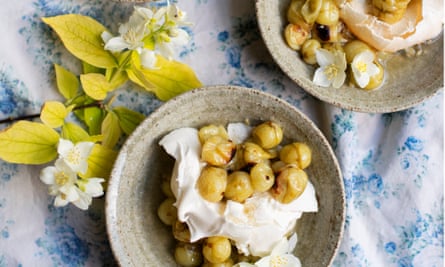
There was a blissfully summery dinner on the table this week. A salmon pie, the pastry crisp, the filling soft and creamy – a mixture of spinach, salmon and crème fraîche. The pie was followed by a dessert of honey-sweetened gooseberries and crisp meringues with centres like marshmallow. It was the first evening meal in the garden this year, and was memorable for both its seasonality and ease.
I dearly love a fish pie, topped with a thick layer of buttery mash, a coulibiac, too, with the fish wrapped inside a pastry crust, but a potato-topped version feels heavy and unseasonal and I don’t always have time for such marathon cooking (bake the fish, make the sauce, peel the spuds, make the mash… you get my drift). So, this time, a light and summery pie made with wafers of filo pastry to offer contrast to the creamy pink and green filling, the whole thing made in the time it takes to peel and mash the potatoes of a traditional pie.
There is little I like more than the first gooseberry crumble of summer. The coarse sugary rubble on top of tart, refreshing berries underneath. But I also like them cooked under the grill, so they toast here and there. They need a splosh of sweet juice – this time I cooked them in elderflower cordial and honey, then spooned the berries and their juices over individual meringues: a sort of pavlova without the blanket of whipped cream.
Salmon and spinach pie
As much as I love a fish pie, they can be quite a task to put together. This one is straightforward, with a pleasing crispness to the crust to contrast the soft and creamy filling. When cooking the leeks, I like to soften them over a low heat, with a piece of greaseproof paper on top and a lid. The result is leeks that steam in their own sweet juices, without browning. Serves 4
salmon 400g
leek 1, large
butter 40g
peas 250g podded weight, fresh or frozen
crème fraîche 250g
parsley 3 tbsp, chopped
dill 3 tbsp, chopped
lemon 1, finely grated zest
spinach 400g
filo pastry 4 sheets
melted butter 50g
Set the oven at 200C/gas mark 6. Line a baking dish or roasting tin with foil, place the salmon pieces on top, season lightly, trickle with a little olive oil, then bake for 15-20 minutes until lightly cooked.
Trim the leek, discarding the root and top of the leaves. Cut into 1cm thick pieces, then wash thoroughly in cold water and shake dry.
Melt the butter in a deep saucepan, add the leek, cover with a circle of greaseproof paper, cover with a lid, then cook over a low to moderate heat until they are soft but not browned.
Add the peas to the leeks and cook for 2 minutes, then stir in the crème fraîche and season with salt and black pepper. Stir in the herbs and lemon zest.
Wash the spinach and place it, still wet, in a medium-sized pan over a high heat, cover with a lid and steam for a couple of minutes. Turn the leaves over, cover and steam again for a minute or two until the leaves have relaxed. Remove from the heat, drain, then squeeze almost dry and roughly chop. Stir into the leeks and peas.
Break the salmon into large, juicy flakes and add to the leeks. Stir without crushing the fish.
Place a piece of filo pastry on the base of a rectangular metal baking dish, about 30cm x 20cm, then brush with melted butter, lay a second on top, then brush with more butter. Transfer the salmon filling on top of the pastry, then 2 more pieces of pastry and melted butter. Bake for 20-25 minutes until golden.
Grilled gooseberries and lemon zest meringues
You can bake instead of grill the gooseberries if you prefer. They make a good breakfast dish this way, too. In the short time they are in season, I cook a pan of them once a week, to eat with yoghurt and oats in the morning. It’s worth remembering that gooseberries are one of the few fruits that freeze well. I keep a healthy stock of them in boxes in the freezer. This makes more meringues than you will need. They will keep for a few days in a plastic storage box. Serves 4 (with meringues for later)
For the meringues:
egg whites 4, large
white wine vinegar 1 tsp
caster sugar 200g
lemon 1, small, finely grated zest
For the gooseberries:
gooseberries 400g
honey 1 tbsp
elderflower cordial 3 tbsp
Put the egg whites in the bowl of a food mixer fitted with a whisk attachment, then beat until stiff and frothy. Lower the speed and add the vinegar and sugar, about 50g a time, only adding more when the last load has been whisked in. When all the sugar has been added, keep whisking until stiff and glossy (use a hand whisk if you prefer).
Finely grate the zest from the lemon, then fold into the beaten meringue. Set the oven at 120C/gas mark 1. Line a baking sheet with parchment, then place 1 large spoonful of the meringue mixture on to the parchment, leaving room around each. They won’t spread much, but need the room to become crisp all over. Bake the meringues for 60-90 minutes until crisp.
To bake the gooseberries: set the oven at 200C/gas mark 6. Remove the stalks and flowers from the gooseberries, drop the fruit into a baking dish, then add the honey and the elderflower cordial and stir to cover the berries. Bake for about 25 minutes until the berries are tender.
Put the berries into serving dishes and add a meringue to each, spooning the juices over the top.
We publish recipes for fish rated as sustainable by the Marine Conservation Society’s Good Fish Guide
Follow Nigel on Instagram @NigelSlater



